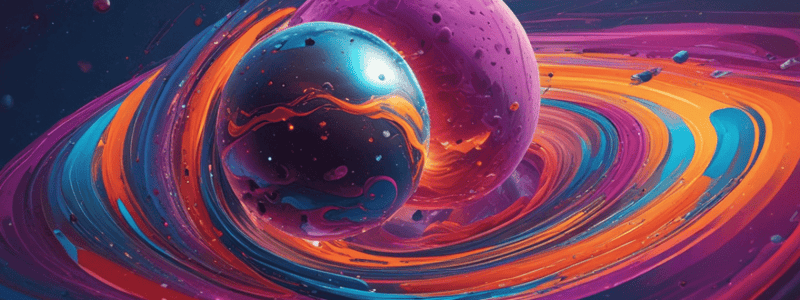Podcast
Questions and Answers
What is the primary reason that planets and stars are roughly spherical in shape?
What is the primary reason that planets and stars are roughly spherical in shape?
- The collision and merging of smaller objects
- The radial gravitational attraction toward the center of mass (correct)
- The uniform distribution of mass within the object
- The increase in rotational speed over time
How does the rotational speed of a planet or star affect its shape?
How does the rotational speed of a planet or star affect its shape?
- Increased rotational speed causes the object to become more spherical (correct)
- Rotational speed has no effect on the shape of the object
- Increased rotational speed causes the object to become more irregular in shape
- Increased rotational speed causes the object to become more elliptical
What is the relationship between a celestial body's mass distribution and its shape?
What is the relationship between a celestial body's mass distribution and its shape?
- The shape of a celestial body is independent of its mass distribution
- The more the mass is distributed toward the edges, the more spherical the shape
- The more concentrated the mass at the center, the more spherical the shape (correct)
- The more uniform the mass distribution, the more spherical the shape
How does the concept of an ice skater spinning more quickly when their arms are brought closer to their body relate to the shape of planets and stars?
How does the concept of an ice skater spinning more quickly when their arms are brought closer to their body relate to the shape of planets and stars?
What is the role of gravitational attraction in determining the shape of planets and stars?
What is the role of gravitational attraction in determining the shape of planets and stars?
What is the primary factor that determines the strength of gravity between two objects?
What is the primary factor that determines the strength of gravity between two objects?
Which of the following statements about gravitational fields is true?
Which of the following statements about gravitational fields is true?
What keeps planets and moons in orbit?
What keeps planets and moons in orbit?
How does the strength of gravity in the solar system compare to gravity on a single planet?
How does the strength of gravity in the solar system compare to gravity on a single planet?
What determines an object's weight?
What determines an object's weight?
According to Newton's law of universal gravitation, what is the relationship between the gravitational force and the masses of the two objects involved?
According to Newton's law of universal gravitation, what is the relationship between the gravitational force and the masses of the two objects involved?
Why do planets orbit the Sun instead of the other way around?
Why do planets orbit the Sun instead of the other way around?
What is the process by which smaller objects collided and stuck together to form larger objects in the early solar system called?
What is the process by which smaller objects collided and stuck together to form larger objects in the early solar system called?
According to Newton's law of gravitation, how does the gravitational force between two objects change as the distance between them increases?
According to Newton's law of gravitation, how does the gravitational force between two objects change as the distance between them increases?
What is the primary reason why we feel Earth's gravity but not the gravitational fields of other planets?
What is the primary reason why we feel Earth's gravity but not the gravitational fields of other planets?
Flashcards are hidden until you start studying




